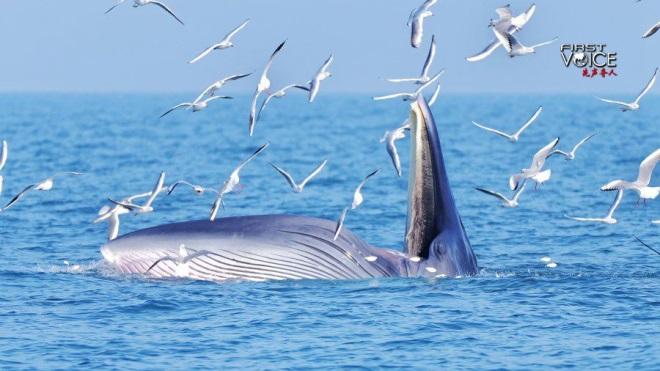
By Ding Duo
The Philippine government, together with Washington, showcases its adeptness at discrediting China, even in environmental protection. Apart from blaming Beijing for "bullying" smaller countries, Manila accuses China of dumping cyanide into the South China Sea, destroying marine habitats and jeopardizing local fishing livelihood.
Is China a polluter, or a protector, of the South China Sea marine environment?
Last summer, at least 15 whale species were spotted in a scientific expedition by Chinese researchers in the northern waters of the South China Sea. As a flagship species of marine ecosystems, whales are indicative of the local environmental conditions, and the finding, according to researchers, provides evidence of the rich whale biodiversity within the surveyed waters.
As a coastal country bordering the South China Sea, China has put relentless efforts into protecting the marine environment that have yielded significant returns. According to China's Ministry of Ecology and Environment, in 2022, the sea area with water quality failing to meet the Seawater Quality Standard Grade I was 9,540 square kilometers, falling by 2,120 square kilometers compared with that in the previous year.
The water quality of the offshore oil/gas exploration zones in the South China Sea met Seawater Quality Standard Grade I. Nearly 50 species of live coral reefs in the Xisha Qundao were monitored, with a coral coverage of 19.6 percent and nearly 120 species of coral reef fish, indicating that the coral reef ecosystem was in a healthy status.
As a staunch supporter of regional peace and stability, China has always maintained its strategic focus in the face of turbulent regional and international situations. While safeguarding its legitimate rights and interests, China has persistently promoted cooperation in less sensitive areas in the South China Sea.
Even when the Marcos government started to show signs of provocations last year, China still maintained patience, extended goodwill and proposed initiatives for cooperation on fisheries, marine environmental protection and the management of marine plastic waste. These initiatives are believed to be highly consistent with Manila's need to strengthen its marine governance capabilities.
But no country can go it alone on marine governance. Over the past decades, China and ASEAN have set up relevant platforms and established mechanisms to protect the environmental and biological resources in the South China Sea. These endeavors have turned out to be essential in curbing the rapid deterioration of the ecosystem and biodiversity, and in the meantime have created favorable conditions for bridging differences and promoting mutual trust among parties to the South China Sea disputes.
China-ASEAN cooperation demonstrates that countries in the region are in urgent need of protecting the marine environment and preserving the fishery resources, and have a solid people-to-people foundation for transforming consensus into practical actions.
But still, challenges exist.
For instance, the Asia Foundation estimates that 64 percent of the region's fisheries are facing a medium- to high-level threat of collapse. The Philippines, to a large extent, is to blame. Apart from overfishing, the Philippines is seen as adept at poisoning fish with cyanide, creating explosions in the sea using dynamite or hand grenades, and dragging bottom trawling nets over seagrass beds or coral reefs. These have exacerbated the marine biodiversity crisis in the region.
Worse still, the Philippines, according to Asia News, has the largest share of global plastic waste discarded in the ocean. In the Coral Triangle alone, over 20,000 square kilometers of coral reefs have been directly affected by pollution. According to a 2021 report by Oxford University's Our World in Data, roughly 80 percent of global ocean plastic comes from Asian rivers, and the Philippines alone contributes a third of that total. Operation 30 Days at Sea by Interpol has also reported cases of marine contamination uncovered in the Philippines.
In addition, regional countries face a common challenge of oil pollution. In February last year, an oil tanker carrying 800,000 liters of industrial fuel oil sank off the central island of Mindoro in the Philippines. Oil washed up 350 kilometers away from where the oil tanker went down, polluting coral reefs, mangroves and seagrass beds in the region, according to media reports. Damage caused would take a long time to recover.
While a large number of commercial and fishing vessels sail through the South China Sea every year, regional countries have not yet established a scientific and efficient coordination mechanism for oil spill prevention and treatment, nor do they have an emergency plan. If a similar incident occurs another time, the negative impacts on the marine environment and the ecosystem could be unimaginable.
Anyone with a conscience would feel heartache upon seeing the piles of plastic waste accumulated on the shores of Manila Bay, the sight of oil and water mixture seeping out along the coast of Mindoro and the whitened coral colonies in the Karimun Islands as a result of cyanide.
Only a clean South China Sea can truly benefit all parties and future generations. If the Philippines is concerned about the marine environment, stopping pouring dirty water on others and cooperating with regional countries, including China, on environmental protection would be the first logical step.
Ding Duo, a special commentator on current affairs for CGTN, is the deputy director and an associate research fellow at the Research Center for Ocean Law and Policy, at the National Institute for South China Sea Studies.

 中文
中文



